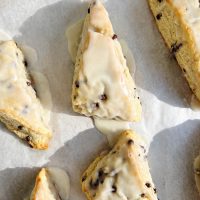
Tender, Buttery Chocolate Chip Scones
These buttery, tender scones are scattered with bites of rich, mini chocolate chocolate chips and a not-too-sweet icing. The icing keeps the scone moist and tender, and a creamy, flaky scone base holds the whole affair together.
Servings 8 scones
Ingredients
- 1/2 cup [120 g] crème fraîche
- 1 large egg
- 1 large egg yolk
- 1 teaspoon pure vanilla extract
- 2 1/4 cup [320 g] all-purpose flour
- 1/4 cup [50 g] granulated sugar
- 1 tablespoon baking powder
- 1/2 teaspoon fine salt
- 12 tablespoons [1 1/2 sticks or 170 g] unsalted butter, cold, and cut into 1/2 in [12 mm] pieces
- 1/3 cup [50 g] mini chocolate chips
- Heavy cream, for brushing
Icing
- 1 tablespoon unsalted butter, melted
- 2 to 4 tablespoons water
- 1/2 teaspoon pure vanilla extract
- Pinch salt
- 1 1/4 cup [150 g] confectioners' sugar
Instructions
For the scones
- Line a sheet pan with parchment paper. In a medium bowl or liquid measuring cup, whisk together the crème fraîche, egg, yolk, and vanilla. Set aside.
- In the bowl of a stand mixer fitted with a paddle, combine the flour, sugar, baking powder, and salt. Add the butter and mix on low speed until the flour-coated pieces are the size of peas.
- Remove the bowl from the mixer and use a spatula to fold the wet ingredients into the dry until just combined. Add the chocolate chips and mix again until combined. Transfer the dough to a lightly floured surface and knead four to six times, until the dough comes together, adding more flour as necessary if the dough is sticky. Pat the dough gently into a square and roll it into a 12 in [30.5 cm] square, dusting with flour as necessary. Fold the dough in thirds, like a business letter. Fold the dough in thirds again by folding in the short ends, making a square. Transfer it to the prepared sheet pan and put it in the freezer for 10 minutes. You can watch a video here to see how to do this step.
- Return the dough to the floured surface, roll it into a 12 in [30.5 cm] square, and fold it in thirds. Turn over the dough so it’s seam-side-down, and gently roll out the dough into a 12 by 4 in [30.5 by 10 cm] rectangle. With a sharp knife, cut it crosswise into four equal rectangles, then cut each rectangle diagonally into two triangles. Transfer the scones to the prepared sheet pan and freeze the scones while the oven is preheating.
- Meanwhile, position an oven rack in the middle of the oven and preheat the oven to 375F [190C]. Stack the sheet pan with scones on another sheet pan. Brush the tops of the triangles with a little heavy cream, making sure it doesn’t drip down the sides. Bake until the tops and bottoms are light golden brown, rotating the pans halfway through, 18 to 25 minutes.
For the icing
- While the scones are baking, in a medium bowl, whisk together the melted butter, water, vanilla, and salt until smooth. Add the confectioner’s sugar and use a spatula to mix together, then whisk until well combined and smooth. Add more water, one tablespoon at a time, to thin the icing to your preferred consistency; the icing should be thick but pourable.
- Transfer the top sheet pan to a wire rack and ice the scones immediately, using the back of a spoon or offset spatula. Scones are best eaten the same day they are made.
Variations
- Espresso-Chocolate Scones: Add 1 teaspoon finely ground espresso to the bowl with the dry ingredients. Replace the water in the icing with room temperature espresso or strong coffee. Cardamom-Espresso-Chocolate Scones: Add 2 teaspoons ground cardamom to the bowl with the dry ingredients. Replace the water in the icing with room temperature espresso or strong coffee.
Notes
** Throughout my recipes posted on this website, 1 cup of flour equals 142 grams. Please note that 1 cup of flour can range anywhere from 120 to 142 grams, depending on the baker or website. I found that after weighting many cups of flour and averaging the total, mine always ended up around this number. If I am posting a recipe from another cookbook, I will use whatever gram measure of flour used in that book, which is why you may see a few posts with a different cup measurement.
Different brands of flour have varying levels of protein, ranging from low to high, which can result in very different outcomes when baking. I’ve found Gold Medal all-purpose unbleached flour to be the best option for many of my recipes; I use it in all the baked goods that don’t use yeast. For yeasted doughs that call for all-purpose flour, I like to use King Arthur Brand.